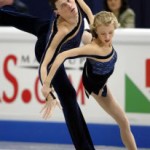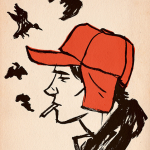Every week in The Kiddy Pool, Erin Newcomb confronts one of many issues that parents must deal with related to popular culture.
I love swimming with my elder daughter. We are members of the local YMCA and use the pool regularly. Sometimes we swim in lanes if there is a vacancy, because my daughter admires the swimmers who wear “special glasses and hats” while they swim underwater. Sometimes she plays on the ramp, creating imaginary houses and gardens while she fills and refills a plastic watering can. Sometimes she glides around the pool with a kick board or rides on a noodle that we pretend is a seahorse. With my toddler, the possibilities are endless, and she sees the pool as yet another space to cultivate her imagination. This is one of the traits that I understand and love best about her, so the swimming pool has become a place for us to relax in the water and exercise our imaginations together.
It’s obvious to me that my daughter loves these outings, so it surprised me this week when a swimmer whom we see frequently asked me if she was enjoying herself. “She’s not smiling,” the woman said when I assured her that we were both having fun. No, I thought, she’s not smiling because a stranger is nearby. A few minutes earlier she was cracking up on her “seahorse,” but, overall, my older child is not the smiley-happy sort. I don’t find that unusual, since her dad and I are not that way either, and, in our family, it’s the second baby, the mellow one who smiles easily who seems like the oddball. Since birth, my toddler has exhibited all the traits that characterize introversion; she is cautious, reserved, observant. She is also a happy child, though that’s not something she’s likely to exhibit amongst strangers or when she feels like she’s on display. What surprises me, again and again, is the expectation of grown-ups that children, simply by virtue of being children, owe them smiles and high fives.
These kinds of interactions bring to my mind Susan Cain’s 2012 book Quiet: The Power of Introverts in a World that Can’t Stop Talking. The prevailing mainstream mentality is that wanting to be by oneself sometimes (or a lot) is selfish, anti-social, and ultimately broken. Yet Cain’s Quiet argues precisely the opposite. Throughout her text, Cain asserts that critical traits like creativity, exceptional achievement in any field (from technology to the arts to athletics), and ethical-decision making require working alone. It is in the intensely thoughtful, sometimes obsessive ruminations of introverts that the brightest ideas often occur—not in the ubiquitous group work that Cain says produces lots of ideas but few brilliant ones. Introverts and extroverts alike need to balance group interactions with time alone, a dualism known throughout monastic history as the active and contemplative lives.
Introverts certainly don’t corner the market on creativity, achievement, or ethics, but our culture is so skewed toward extroversion that the belief in group power prevails even as it fails. Cain marks the early 20th century as the cultural shift toward the extroverted ideal; she claims that U.S. society moved from a “culture of character” to a “culture of personality.” The former is characterized by “citizenship, duty, work, golden deeds, honor, reputation, morals, manners , integrity” and the latter by descriptors like “magnetic, fascinating, stunning, attractive, glowing, dominating, forceful, energetic” (21–24). I can’t help but feel like the “culture of personality” exists only on the surface. Both introverts and extroverts run deeper than a superficial personality, but it’s intimacy that teaches us about the depths of relationships—no matter how smiley the outer façade may be.
It’s my job to teach my daughter friendliness, social graces the illustrate consideration for others, but as I strive to teach her virtuous behavior, I’m conscious of the distinction between appearing considerate and actually being considerate. Lots of smiling and a “big” personality are superficial indicators that may or may not reflect the heart’s feelings for others. For extroverts and introverts alike, it’s not the exterior that matters but the interior, the heart from which true feelings flow regardless of the accompanying expression. Cain’s book talks about the necessity of “restorative niches” for introverts—spaces (sometimes within one’s own imagination) carved out for solace and reflection from the fast-paced, extroverted culture. The phrase reminds me of how frequently Christ withdrew from crowds to be alone, to meditate and pray and reflect in ways impossible within a large group. Like Christ, the children of God need to move between those two spaces of action and contemplation, extroversion and introversion, but some of us, no matter how joy-filled our hearts, just aren’t going to smile about it much.











